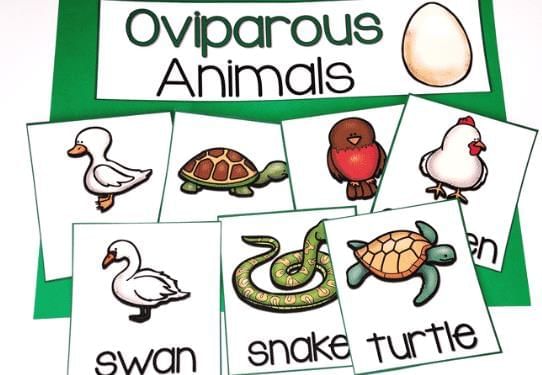Class 4 Exam > Class 4 Questions > State whether the following statement is True...
Start Learning for Free
State whether the following statement is True or False:
The animals which give birth to their young ones through eggs are called viviparous animals.
- a)True
- b)False
Correct answer is option 'B'. Can you explain this answer?
Most Upvoted Answer
State whether the following statement is True or False:The animals whi...

- False. The statement is False.
- Oviparous animals are the ones that lay eggs to give birth to their young ones, not viviparous animals. Viviparous animals give birth to their young ones directly, not through eggs. For example, mammals like humans, dogs, and cats are viviparous animals because they give birth to live young ones.
Free Test
FREE
| Start Free Test |
Community Answer
State whether the following statement is True or False:The animals whi...
Understanding Viviparous vs. Oviparous Animals
The statement provided is False. To clarify, let's examine the definitions of viviparous and oviparous animals.
Definitions
- Viviparous Animals:
- These are animals that give birth to live young.
- The embryos develop inside the mother's body, receiving nourishment directly from her.
- Examples include humans, dogs, and whales.
- Oviparous Animals:
- These animals lay eggs, which develop and hatch outside the mother's body.
- The young are born from eggs after a period of incubation.
- Examples include birds, reptiles, and amphibians.
Key Differences
- Nourishment:
- Viviparous animals provide nutrients to the developing young through placenta or similar structures.
- Oviparous animals provide nutrients through the egg's yolk.
- Birth Method:
- Viviparous animals give birth to live offspring.
- Oviparous animals hatch their young from eggs.
Conclusion
In summary, the statement claiming that animals giving birth to their young through eggs are called viviparous is incorrect. They are actually referred to as oviparous animals. Understanding these terms is crucial for classifying animals based on their reproductive methods.
The statement provided is False. To clarify, let's examine the definitions of viviparous and oviparous animals.
Definitions
- Viviparous Animals:
- These are animals that give birth to live young.
- The embryos develop inside the mother's body, receiving nourishment directly from her.
- Examples include humans, dogs, and whales.
- Oviparous Animals:
- These animals lay eggs, which develop and hatch outside the mother's body.
- The young are born from eggs after a period of incubation.
- Examples include birds, reptiles, and amphibians.
Key Differences
- Nourishment:
- Viviparous animals provide nutrients to the developing young through placenta or similar structures.
- Oviparous animals provide nutrients through the egg's yolk.
- Birth Method:
- Viviparous animals give birth to live offspring.
- Oviparous animals hatch their young from eggs.
Conclusion
In summary, the statement claiming that animals giving birth to their young through eggs are called viviparous is incorrect. They are actually referred to as oviparous animals. Understanding these terms is crucial for classifying animals based on their reproductive methods.

|
Explore Courses for Class 4 exam
|

|
Question Description
State whether the following statement is True or False:The animals which give birth to their young ones through eggs are called viviparous animals.a)Trueb)FalseCorrect answer is option 'B'. Can you explain this answer? for Class 4 2025 is part of Class 4 preparation. The Question and answers have been prepared according to the Class 4 exam syllabus. Information about State whether the following statement is True or False:The animals which give birth to their young ones through eggs are called viviparous animals.a)Trueb)FalseCorrect answer is option 'B'. Can you explain this answer? covers all topics & solutions for Class 4 2025 Exam. Find important definitions, questions, meanings, examples, exercises and tests below for State whether the following statement is True or False:The animals which give birth to their young ones through eggs are called viviparous animals.a)Trueb)FalseCorrect answer is option 'B'. Can you explain this answer?.
State whether the following statement is True or False:The animals which give birth to their young ones through eggs are called viviparous animals.a)Trueb)FalseCorrect answer is option 'B'. Can you explain this answer? for Class 4 2025 is part of Class 4 preparation. The Question and answers have been prepared according to the Class 4 exam syllabus. Information about State whether the following statement is True or False:The animals which give birth to their young ones through eggs are called viviparous animals.a)Trueb)FalseCorrect answer is option 'B'. Can you explain this answer? covers all topics & solutions for Class 4 2025 Exam. Find important definitions, questions, meanings, examples, exercises and tests below for State whether the following statement is True or False:The animals which give birth to their young ones through eggs are called viviparous animals.a)Trueb)FalseCorrect answer is option 'B'. Can you explain this answer?.
Solutions for State whether the following statement is True or False:The animals which give birth to their young ones through eggs are called viviparous animals.a)Trueb)FalseCorrect answer is option 'B'. Can you explain this answer? in English & in Hindi are available as part of our courses for Class 4.
Download more important topics, notes, lectures and mock test series for Class 4 Exam by signing up for free.
Here you can find the meaning of State whether the following statement is True or False:The animals which give birth to their young ones through eggs are called viviparous animals.a)Trueb)FalseCorrect answer is option 'B'. Can you explain this answer? defined & explained in the simplest way possible. Besides giving the explanation of
State whether the following statement is True or False:The animals which give birth to their young ones through eggs are called viviparous animals.a)Trueb)FalseCorrect answer is option 'B'. Can you explain this answer?, a detailed solution for State whether the following statement is True or False:The animals which give birth to their young ones through eggs are called viviparous animals.a)Trueb)FalseCorrect answer is option 'B'. Can you explain this answer? has been provided alongside types of State whether the following statement is True or False:The animals which give birth to their young ones through eggs are called viviparous animals.a)Trueb)FalseCorrect answer is option 'B'. Can you explain this answer? theory, EduRev gives you an
ample number of questions to practice State whether the following statement is True or False:The animals which give birth to their young ones through eggs are called viviparous animals.a)Trueb)FalseCorrect answer is option 'B'. Can you explain this answer? tests, examples and also practice Class 4 tests.

|
Explore Courses for Class 4 exam
|

|
Signup for Free!
Signup to see your scores go up within 7 days! Learn & Practice with 1000+ FREE Notes, Videos & Tests.























